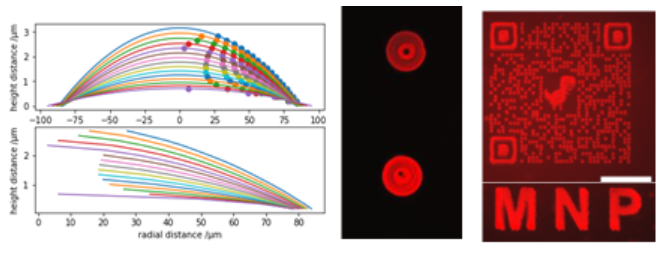Precision Assembly of Quantum dots by Inkjet printing: Modelling and Experiment
- Academic lead
- Mark Wilson, School of Mechanical Engineering, m.wilson@leeds.ac.uk
- Co-supervisor(s)
- Oliver Harlen, School of Mathematics, o.g.harlen@leeds.ac.uk, Kevin Critchley, School of Physics and Astronomy, k.critchley@leeds.ac.uk, Sepideh Khodaparast, School of Mechanical Engineering, s.khodaparast@leeds.ac.uk, Lorna Dougan, School of Physics and Astronomy, l.dougan@leeds.ac.uk
- Project themes
- Energy and Transport, Industrial Processes, Underpinning Methods for Fluid Dynamics
Quantum dots (QDs) are semiconductor nanoparticles that can emit light through either photoluminescence or electroluminescence (EL). The latter enables one to create lighting devices in a very similar way to the OLED devices currently used in display screens. QDs are more robust than organic molecules, which is important when the lighting system is required to work in a wide range of conditions. A promising route for fabricating QD EL devices is to inkjet print them onto the substrate. However, as the tiny ink droplets dry (containing the QDs), they often leave behind rings of QDs (often called coffee rings, Figure 1, middle).
 Figure 1. A droplet drying on a substrate over time monitored by measuring interference fringes (left). A fluorescence of quantum dots deposited onto a substrate through by ink jet printing (~200 µm droplets) (middle). A fluorescence of quantum dots deposited by inkjet printing to create a tiny QR code; white bar is 1mm (right).
Figure 1. A droplet drying on a substrate over time monitored by measuring interference fringes (left). A fluorescence of quantum dots deposited onto a substrate through by ink jet printing (~200 µm droplets) (middle). A fluorescence of quantum dots deposited by inkjet printing to create a tiny QR code; white bar is 1mm (right).
In this project, you will be modelling the properties of the ink and how the drying/evaporation process can be controlled to enable uniform deposition of the QDs onto the substrate surface. Computational simulations will be developed using either the commercial multiphysics software COMSOL or open-source code Oomph-lib, according to your preference. You will then perform experiments to complement the modelling and determine whether the simulations can inform how to engineer the quantum dot inks. Finally, we will evaluate the QD film properties optically and electronically in real devices.
